9 Surprises from a Galápagos Travel Adventure
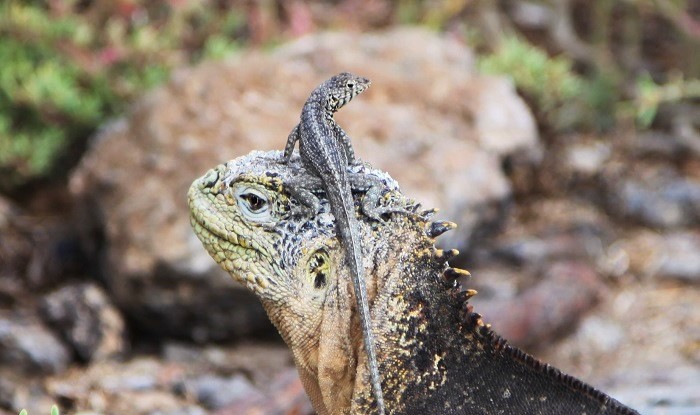
In my mind, the trip hadn’t begun. Yet there before me were two prehistoric-looking marine iguanas sunning themselves on the asphalt parking lot and five sea lions cavorting in the park-side tide pool. No, wait, make that nine sea lions: Another four were lounging on rocks under the pier, camouflaged by their gray, curved, still-as-stone bodies. I’d just arrived on San Cristóbal, the easternmost island of the Galápagos, and didn’t expect to see wildlife in the middle of town, just half a mile from the airport.
This was the first of many surprises I encountered during my week in the Enchanted Islands, the famed archipelago that pops up out of the Pacific Ocean nearly 600 miles west of Ecuador. Here are nine others.
1. It Feels Like Another World
And it’s a world in which animals reign supreme. They welcome us with little concern and curious glances. They trust us to step around them (not realizing how well they blend in). They invite us to play with them in the water. They swoop and screech above us like pterodactyls, transporting us to Jurassic times. And where there is human development, they take happy advantage, basking on sun-drenched benches and in busy fish markets. They come and go as they please. What a treat to be in a place where humans defer to the rhythms of animals. This is their realm, not ours.
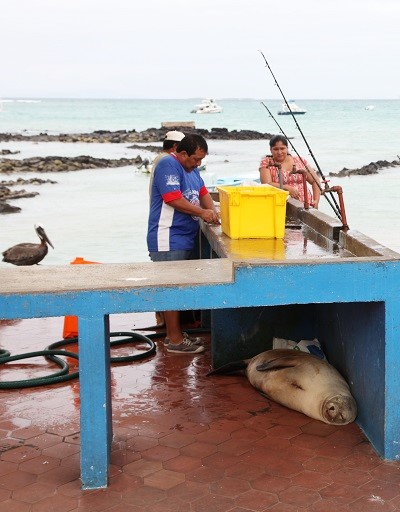
A sea lion naps at the Puerto Ayora fish market. Photo: Amanda McKee
2. Galápagos Cruises Are Fabulous—On the Right Boat
My misgivings about cruises evaporated the instant I boarded the Origin. The yacht itself is amazing—brand new (it still smelled of freshly cut wood), beautifully designed and decorated, and crewed by a well-trained, fun, and attentive staff (including two Class III naturalist guides). It’s small in size (20 guests max), so we could get closer to the islands, but has impressive stabilizing to handle rougher seas. I loved sitting in the hammocks on the sundeck, gathering with the other travelers for briefings (and to watch the Ecuador-USA soccer game) in the lounge, being rocked to sleep each night by the motion of the boat, and waking each morning in a new location. I loved setting off for snorkeling, kayaking, stand-up paddleboarding, and walking excursions, then coming back with a good appetite to fresh juice, snacks, and excellent meals. And I loved not having to face my suitcase for a week.

Sundeck on the Origin, complete with hammocks. Photo: Amanda McKee
3. Albatrosses Have a Funny Way to Flirt
Española Island is the primary breeding ground for the waved albatross, the critically endangered and very large seabird whose wingspan reaches seven to eight feet. As graceful as they appear in flight, they walk like clumsy, uncoordinated teenagers. And when it comes to courtship, they engage in a wonderful dance that involves more awkward head bobbing, really bowing, along with the clicking and circling of beaks, and making cries to the heavens. “They mate for life,” naturalist Gaby explained. “They dance first, then wait to mate until they’ve danced some more. Their dance has eight steps.” It was a thrill to watch.
The albatross courting dance. Video: Amanda McKee
4. Sea Lions Really Do Want to Play
I’ve heard stories about swimming with sea lions, and was elated to experience it myself. The pups would zip right up to me and then dart away. They’d look at me and spin around, asking me to do the same. And when I rolled, they did, too. Their speed underwater was astonishing and their playfulness—surfing breaking waves, flipping in the water and jumping out of the water with their sea lion friends—evoked pure joy.
Spinning with a sea lion. Video: Amanda McKee
5. Male Frigate Birds Go Big
You have to wonder about evolution when you see frigate birds in the Galápagos. Males attract mates by inflating their gular pouch—the bigger and redder, the better. I was shocked not only by the sheer size of the balloon (making movement challenging), but by the fact that they fly with it (which also looks uncomfortable and not particularly aerodynamic). “It takes about 20 minutes to inflate the pouch and 10–20 minutes to deflate it,” explained Gaby. “So if they have an opportunity to get food while inflated, they do it. I’ve seen them chasing other birds and dipping into the sea to find food that way.” Once they find a mate, the pouch deflates, indicating they are no longer on the market.


Frigate birds with inflated gular pouches at North Seymour Island. Photos: Amanda McKee
6. I Swam with Sharks—and Penguins, Rays, Turtles—and Survived!
I was excited—and nervous—to snorkel at Devil’s Crown, a partially submerged eroded volcano where white-tipped reef sharks are often spotted. I wanted to see one … kind of. Within minutes of being in the water, my eyes locked on two hanging out on the seafloor about 30 feet below me. I calmed a bit, appreciating the generous distance between us. But some 25 minutes later, when I was ogling bright blue-green parrotfish and schools of yellowfin angelfish on the other side of the crown, another shark came out of nowhere and swam right past me. It moved with such tranquil elegance that I didn’t panic—well, not much, anyway.
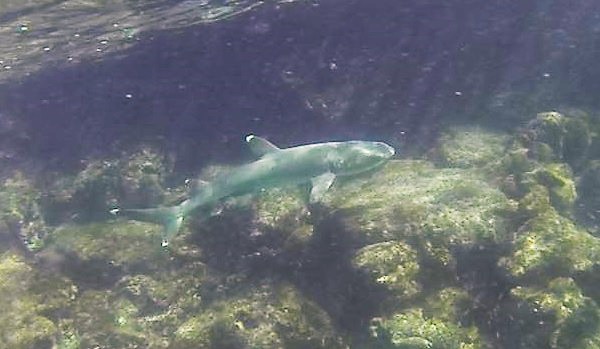
A white-tipped reef shark swims past me only a little close for comfort. Photo: Amanda McKee
During our underwater outings, I was delighted to share the sea with torpedo-like Galápagos penguins (the world’s smallest penguins and the only ones living north of the equator), diamond stingrays, a multitude of colorful sea stars, pufferfish, schools of silvery sardines, sea turtles, rainbow chub, black striped salema, sergeant majors, long and slender cornetfish, sea urchins, wonderful lava and coral formations, and diving pelicans.
7. Each Galápagos Island Is a Different Adventure
Upon waking each morning, I’d roll over and look out the window to see what awaited us. It never ceased to amaze me how these islands that looked similarly arid and uninviting from afar had their own colorful, thriving characters up close. Even with our pre-landing naturalist briefings, the unique combinations of flora, fauna, and geology constantly surprised us.
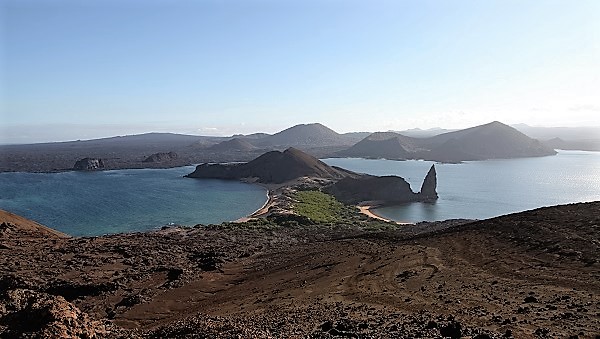
View of Pinnacle Rock from summit on Bartolomé Island. Photo: Amanda McKee
We climbed through slot canyons below sculpted lava peaks to find nesting grounds of Nazca, red-footed, and blue-footed boobies (this northern point of San Cristóbal is the only site where all types of boobies can be found nesting).

Juvenile blue-footed boobies are as big as their parents. Photo: Amanda McKee
On Española, the oldest of the islands, we followed the uplifted sea floor to rounded rocks with perching marine iguanas and through waist-high brush in which finches were fluttering; overhead Galápagos hawks (the top predator here) circled looking for prey.

Marine iguanas happily pile on top of each other. Photo: Amanda McKee
We wandered among giant cactus groves guarded by land iguanas and past sea lions napping in red sesuviem to a cliff bustling with red-billed tropic birds, lava lizards, and Sally Lightfoot crabs.

Sally Lightfoot crabs skitter sideways over the shorelines of these islands. Photo: Amanda McKee
We came across pink flamingos in a brackish lagoon and guava-nibbling giant tortoises in a highland cloud forest that’s thick with tall Scalesia trees, ferns, moss, and orchids.

Giant tortoise on Santa Cruz Island. Photo: Amanda McKee
We saw seawater shooting out of blow holes, explored lava tunnels and skyscrapery rock formations, and spotted surfacing orcas from a wind-whipped volcano—we literally ran down to get on the water in time to find them, and it was worth the effort.

This orca came up for air after swimming straight under our panga. Photo: Amanda McKee
The landscapes and wildlife from island to island, bay to bay, were far more interesting and diverse than I expected.
8. Conservation Is an Ongoing Effort
Many regulations are in place to protect the Galápagos Islands, a UNESCO World Heritage Site and national park, but demands on resources continue to grow as the local population and number of visitors increases—at the time of the last census, in 2010, there were about 25,000 residents on the four inhabited islands and 145,000 visitors. (Some estimate that current numbers have risen to 30,000 and more than 200,000 respectively.) Work is being done to educate, conserve, and find new solutions for fresh water and energy, to prevent overfishing and the spread of invasive species, and to promote sustainable tourism. Solar and wind power is gaining traction and the islands are striving to be self-sufficient and fossil-fuel free.
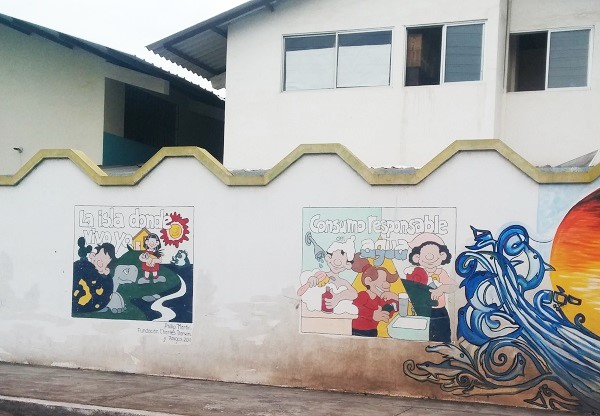
Murals in Puerto Ayora offer lessons about taking care of water and the environment. Photo: Amanda McKee
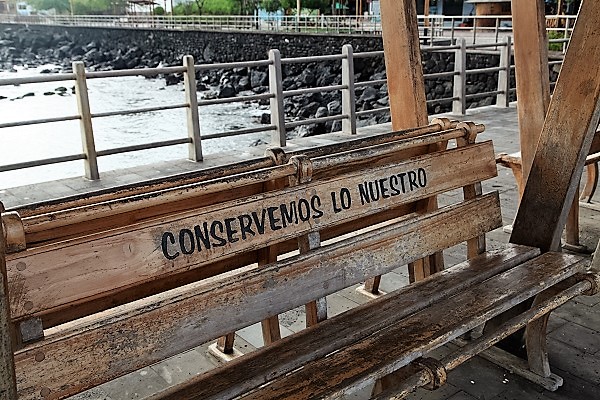
A timeless message in Puerto Baquerizo Moreno, San Cristóbal Island. Photo: Amanda McKee
9. These Islands Are More Amazing Than I Imagined
After all the photos I’d seen over the years, I thought I knew what to expect in the Galápagos. I expected to enjoy the visit … but, in fact, I was completely blown away. By the incredible creatures I got to know and interact with, by the otherworldly landscapes, by being disconnected from the stresses of my everyday life and immersed in nature, by the soothing warm air and refreshing ocean water, by the kind people with whom I shared the week, by the FUN of the excursions, by the surprises of all shapes and sizes along the way.

A Nazca booby shares his perch with marine iguanas on Española Island. Photo: Amanda McKee

The Origin anchored by Punta Pitt. Photo: Amanda McKee

A sea lion strikes a common pose at Punta Cormorant, Floreana Island. Photo: Amanda McKee
# # # # #
Amanda McKee’s adventures have taken her from Bhutanese temples and Namibian salt pans to Patagonian estancias, Uzbek mosques, and the summit of Mount Kilimanjaro.

To explore GeoEx’s many options for Galápagos travel—each of which helps support Galápagos conservation efforts—browse our group and custom trips or contact an expert at 888-570-7108.
Image below story title: A lava lizard sits atop an iguana’s head. Photo: Amanda McKee
Thank you, Amanda, for such a lovely description of what it would be like to visit the Galapagos!! This shut-in Grandma thoroughly enjoyed & appreciated it!!! Hugs from this Grandma!!

